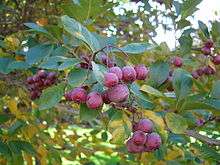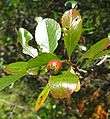Crataegus crus-galli
| Crataegus crus-galli | |
|---|---|
 | |
| a cultivated form | |
| Scientific classification | |
| Kingdom: | Plantae |
| (unranked): | Angiosperms |
| (unranked): | Eudicots |
| (unranked): | Rosids |
| Order: | Rosales |
| Family: | Rosaceae |
| Genus: | Crataegus |
| Series: | Crus-galli (Loudon) Rehder[1] |
| Species: | C. crus-galli |
| Binomial name | |
| Crataegus crus-galli L. | |
| Synonyms[2] | |
| |
Crataegus crus-galli is a species of hawthorn known by the common names cockspur hawthorn and cockspur thorn. It is native to eastern North America from Ontario to Texas to Florida, and it is widely used in horticulture.[3][4] This is a small tree growing up to about 10 meters tall and 8 meters wide, rounded in form when young and spreading and flattening as it matures. The leaves are 5 to 6 centimeters long, glossy dark green in color and turning gold to red in the fall. The flowers are white and have a scent generally considered unpleasant. The fruits are small pomes that vary in colour, usually a shade of red.[4] Most wild varieties of the tree are heavily armed in sharp thorns several centimeters long. This species is a popular ornamental tree, especially var. inermis, which lacks thorns. Many other wild forms would be very suitable for landscaping if better known, and yellow-fruited forms exist.[4]
Images
-

C. crus-galli var. pyracanthifolia
-

C. crus-galli var. pyracanthifolia
-

Thorns on 2 to 3-year old branches
-

Branched thorns on the trunk
See also
References
- ↑ Phipps, J.B.; Robertson, K.R.; Smith, P.G.; Rohrer, J.R. (1990). A checklist of the subfamily Maloideae (Rosaceae). Canadian Journal of Botany. 68(10): 2209–2269.
- ↑ Phipps, J.B. (2015), "Crataegus crus-galli Linnaeus", in L. Brouillet; K. Gandhi; C.L. Howard; H. Jeude; R.W. Kiger; J.B. Phipps; A.C. Pryor; H.H. Schmidt; J.L. Strother; J.L. Zarucchi, Flora of North America North of Mexico, Volume 9: Magnoliophyta: Picramniaceae to Rosaceae, New York, Oxford: Oxford University Press, pp. 538–619
- ↑ USDA Plants
- 1 2 3 Phipps, J.B., O’Kennon, R.J., Lance, R.W. (2003). Hawthorns and medlars. Royal Horticultural Society, Cambridge, U.K. ISBN 0-88192-591-8 ISBN 9780881925913
External links
- Cockspur Hawthorn, Crataegus crus-galli L. (Floyd County, Northwest Georgia, Southeastern United States)
- GRIN Species Profile
- OSU Ornamental Profile
- UCConn Plant Database, copyright Mark Brand